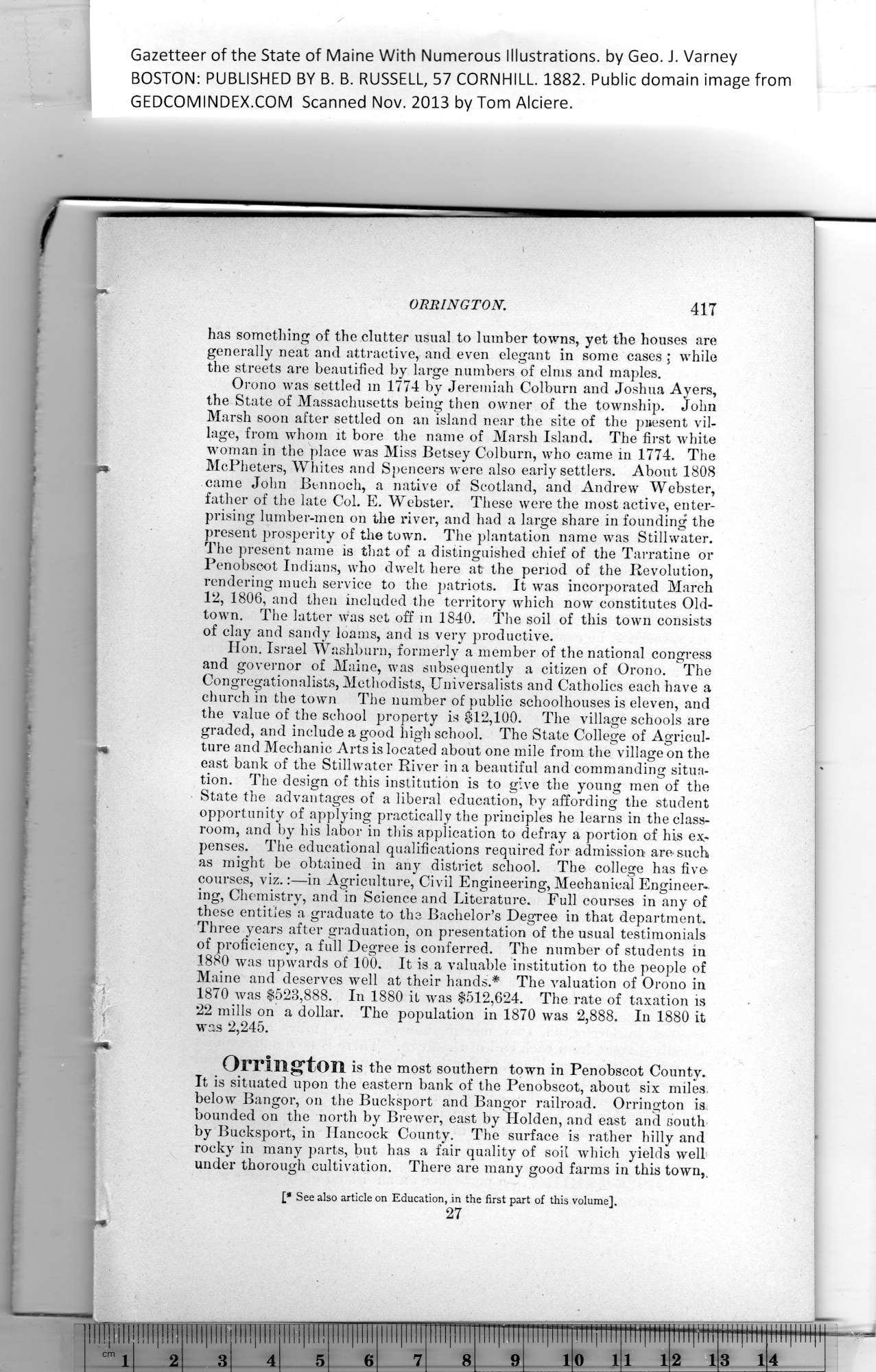|
Gazetteer of the State of Maine With Numerous Illustrations, by Geo. J. Varney
BOSTON: PUBLISHED BY B. B. RUSSELL, 57 CORNHILL. 1882. Public domain image from
ORRINGTON.
has something of the clutter usual to lumber towns, yet the houses are
generally neat and attractive, and even elegant in some cases ; while
the streets are beautified by large numbers of elms and maples.
Orono was settled m 1774 by Jeremiah Colburn and Joshua Ayers,
the State of Massachusetts being then owner of the township. John
Marsh soon after settled on an island near the site of the puesent vil-
lage, from whom it bore the name of Marsh Island. The first white
woman in the place was Miss Betsey Colburn, who came in 1774. The
McPheters, Whites and Spencers were also early settlers. About 1808
came John Bennoch, a native of Scotland, and Andrew Webster,
father of the late Col. E. Webster. These were the most active, enter-
prising lumber-men on the river, and had a large share in founding the
present prosperity of the towm. The plantation name was Stillwater.
The present name is that of a distinguished chief of the Tarratine or
Penobscot Indians, who dwelt here at the period of the Revolution,
rendering much service to the patriots. It was incorporated March
12, 1806, and then included the territory which now constitutes Old-
town. The latter was set off in 1840. The soil of this town consists
of clay and sandy loams, and is very productive.
Hon. Israel Washburn, formerly a member of the national congress
and governor of Maine, Avas subsequently a citizen of Orono. The
Congregationalists, Methodists, Universalists and Catholics each have a
church in the town The number of public schoolhouses is eleven, and
the value of the school property is $12,100. The village schools are
graded, and include a good high school. The State College of Agricul-
ture and Mechanic Arts is located about one mile from the village on the
east bank of the Stillwater River in a beautiful and commanding situa-
tion. The design of this institution is to give the young men of the
State the advantages of a liberal education, hy affording the student
opportunity of applying practically the principles he learns in the class-
room, and by his labor in this application to defray a portion of his ex-
penses. The educational qualifications required for admission are-such
as might be obtained in any district school. The college has five
courses, viz.:—in Agriculture, Civil Engineering, Mechanical Engineer-
ing, Chemistry, and in Science and Literature. Full courses in any of
these entitles a graduate to the Bachelor’s Degree in that department.
Three years after graduation, on presentation of the usual testimonials
of proficiency, a full Degree is conferred. The number of students in
1880 was upwards of 100. It is a valuable institution to the people of
Maine and deserves well at their hands.* The valuation of Orono in
1870 was $528,888. In 1880 it wras $512,624. The rate of taxation is
22 mills on a dollar. The population in 1870 was 2,888. In 1880 it
was 2,245.
Orpington is the most southern town in Penobscot County.
It is situated upon the eastern bank of the Penobscot, about six miles,
below Bangor, on the Bucksport and Bangor railroad. Orrington is;
bounded on the north by Brewer, east by Holden, and east and south
by Bucksport, in Hancock County. The surface is rather hilly and
rocky in many parts, but has a fair quality of soil which yields well
under thorough cultivation. There are many good farms in this town,.
[* See also article on Education, in the first part of this volume],
27
PREVIOUS PAGE ... NEXT PAGE
This page was written in HTML using a program written in Python 3.2
|
